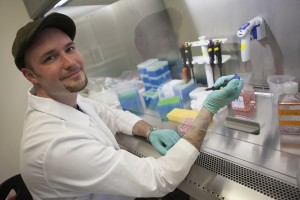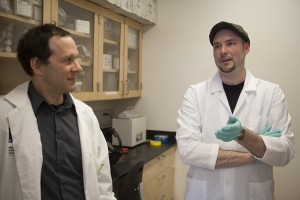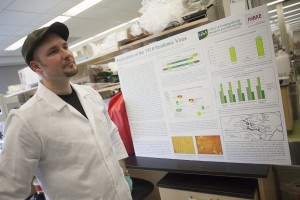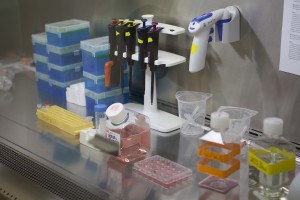Investigating influenza
by Tracy Kalytiak |
Ninety-six years ago, a swift and relentless killer emerged from livestock kept to feed soldiers preparing to fight in World War I, in France. The invisible catastrophe was H1N1 influenza-so tiny that 42 of its pincushion-like viruses would fit across a strand of spider silk; so deadly it snuffed out the lives of nearly 5 percent of the world's population and became known as Alaska's worst natural disaster.

University Honors College student Robert Robl is trying to better understand the deadly 1918 H1N1 virus to help prevent and treat pandemic flu strains in the future. Photo by Philip Hall/University of Alaska Anchorage.
UAA University Honors College student Robert Robl and Dr. Eric Bortz, a UAA biological sciences professor, want to learn just what made the 1918 H1N1 virus spread and kill so quickly, and hope their research might uncover better ways to prevent and treat pandemic flu strains in the future.
Coughs, sneezes and unwashed hands propelled H1N1 around the globe in 1918. The flu arrived in Nome that October via steamships and sidled past quarantines. Crew members exposed to flu helped mail carriers load their dogsleds, which they rode to villages where thousands of Alaska Native men, women and children lived, isolated from doctors and others who could help them.
The 1918 strain of H1N1-also known as "Spanish flu"-often killed its victims within days or even hours after the first symptoms appeared. The viral infection would inflict severe tissue damage in the lungs, making victims more vulnerable to bacterial pneumonia. Fluid pooled in inflamed lungs essentially drowned flu victims.The pandemic sickened 500 million people and swept an estimated 50-100 million souls from the world, before subsiding sometime before 1920. The descendants of the 1918 H1N1 virus persisted as weakened seasonal flu strains until another descendant of the 1918 virus, the 2009 pandemic swine-origin influenza (also an H1N1), replaced it.
Opening a new path
Robl, who won this year's Fran Ulmer Transformative Award, didn't know about the 1918 flu pandemic before meeting Bortz, a researcher who moved to UAA two years ago from Mount Sinai School of Medicine in New York.
When it came time for Robl to start working on an honors thesis, his genetics professor, Ben Harrison, told him Bortz had recently arrived. Robl requested and received an interview.
"We hit it off right away," he said. "[Bortz] said he studied pandemics, horrible outbreaks of flu virus and he said, 'Ever hear of the 1918 flu?' I was deeply fascinated and went to the library, got some books on the topic. It was the horror of that pandemic that sparked my interest. That flu has been studied for 90 years. It's the trillion-dollar question in the field, so you have to find some small niche in the research that has not been investigated."
Robl and Bortz are examining the potential of an antiviral factor in the human body-a protein known as NF90-to frustrate a flu strain's attempt to transform human lung cells into molecular-level factories.

Biological sciences professor Dr. Eric Bortz, left, arrived at UAA two years ago from Mount Sinai School of Medicine in New York. He inspired Robert to study the "Spanish Flu." Photo by Philip Hall/University of Alaska Anchorage.
"[NF90 is] an antiviral factor our cells produce that inhibits Ebola virus, looks like it inhibits some influenza viruses, makes [cells] a little bit resistant to incoming viruses," Bortz said. "We're studying how it does that. It seems to block the virus' ability to make copies of its RNA genome."
The 1918 virus had disappeared years before, to the chagrin of researchers who wanted to learn what distinguished it from less virulent forms of H1N1.
In 1951, researcher Johan Hultin tried to find live virus in the mass grave of flu victims buried in permafrost at Brevig Mission, where flu had killed 72 of the village's 80 people. Hultin returned in 1997 and took the lungs of an obese Brevig Mission flu woman exhumed from that permafrost grave-the woman's fat had preserved her lungs from decay. Hultin found enough of the 1918 virus' genetic material to reconstruct it.
"We've attenuated them, weakened them a bit in the laboratory so they're not pathogenic to humans anymore," Bortz said. "[Robl] is studying molecular factors that make the difference between the 1918 pandemic flu and the seasonal flu someone gets. And, he's studying how well flu viruses can make copies of themselves inside of our human cells."
The 1918 flu virus normally contains eight gene segments. Robl and Bortz-for safety's sake-work with a weakened version of that virus that has four segments that snap together to form what they call a "replication complex."
How flu behaves
People catch the flu by breathing in virus from an infected person's sneezes or coughs, or by touching an infected surface (like a doorknob) and then conveying the virus to the eyes, nose or mouth.
The virus enters the respiratory passage of the lungs and then behaves much like a Trojan horse: it binds to the surface of a cell, tricks the cell into engulfing it and then places its genetic blueprint-RNA-into the cell's nucleus. The virus then takes over the cell and churns out copies of itself that spread and infect other cells of the body after the cell finally dies.

Robert stands next to his research poster for the 2014 Undergraduate Research and Discovery Symposium. Photo by Philip Hall/University of Alaska Anchorage.
"Flu is completely reliant on your proteins; it borrows or kidnaps cell proteins to carry out its work," Robl said. "A lung cell exchanges gases. Ions or water can pass into the cell but larger things need a passport or barcode that give it passage. A virus comes along, the cell recognizes it as material that needs to be imported, because it has the appropriate receptors."
The "H" of H1N1 represents hemagglutinin, spike-like proteins protruding from the virus' surface that fit into receptors on the surface of a human lung cell like a key into a lock. This allows the virus to inject its genetic blueprint-its RNA genome-inside the cell, forcing the cell to manufacture fledgling copies of the virus. The "N" stands for neuraminidase, another spike-shaped substance that helps the virus escape from and destroy the cell, before setting out to infect other cells.
NF90 is a protein that interferes with a virus' attempt to hijack a cell into manufacturing more virus.
An 'evocative line of study'
Developing vaccines to kill the flu is a formidable challenge, because in humans, influenza viruses constantly mutate and so can evade the body's immune system sentries.
Robl conducts his experiments with human lung cancer cells taken from a patient in 1976 that are coddled in 24 wells of a cell culture plate warmed to the same temperature as the inside of a human body. A cell culture plate looks a bit like a miniature plastic version of a muffin pan.
"These haven't filled the dance ticket yet; they're waiting for Rob and Eric's shop of horrors," Robl joked. "We'll grow them in this special medium that supplies the nutrients they need, there's some antibiotics in there, too, then what I'll do is bust them apart...and I'll seed them into the 24 well blocks. You can do a little experiment in each one."
In his experiments, done over the past two years, Robl has added more NF90 to cells, injected virus and noted that NF90 inhibits the virus. He has removed NF90, injected virus and noted that the virus flourished without NF90 present. And, he uses fluorescent probes to see, microscopically, where NF90 travels in the cells.
"I look for a viral protein in the cell and for the NF90 protein," Robl said. "Where are they? When are they?"
Robl and Bortz have been collaborating with labs in New York and Hong Kong and are trying to tease out more about the NF90 interaction with flu. Robl will be working this summer in the bioinformatics section of the National Cancer Institute, but hopes to continue his work and learn just how NF90 binds to flu RNA and flu proteins and how this blocks the virus from replicating.
"NF90 has some profound broad activities against virus in general-Ebola, HIV, three strains of flu-that need to be explored more, studied carefully," Robl said. "All of a sudden my little undergraduate protein has become a very evocative line of study. I hope this helped catch the eye of the research community and turn it toward investigation."
Written by Tracy Kalytiak, UAA Office of University Advancement.
 "Investigating influenza" is licensed under a Creative Commons Attribution-NonCommercial 4.0 International License.
"Investigating influenza" is licensed under a Creative Commons Attribution-NonCommercial 4.0 International License.















